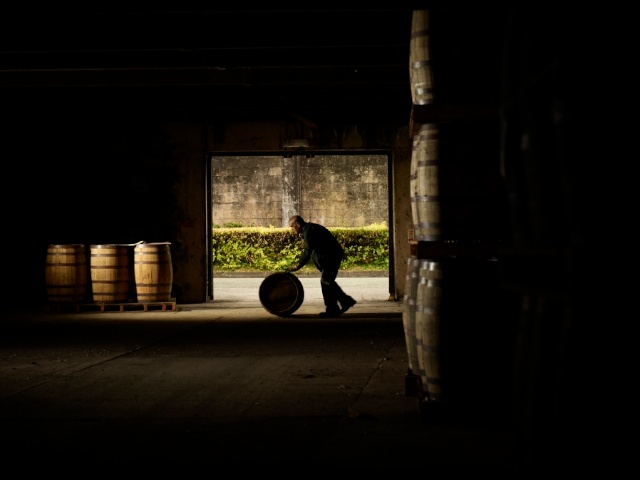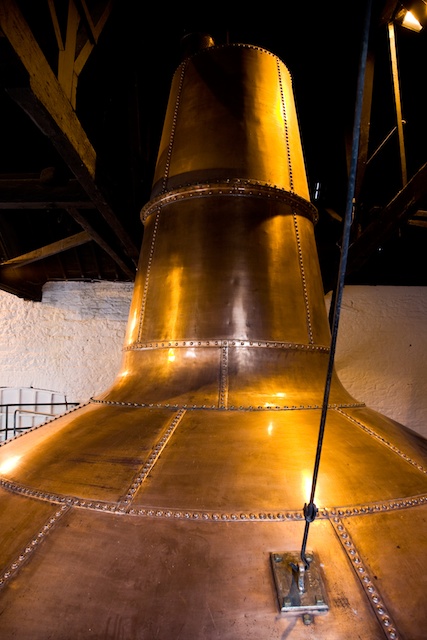An Interview with Midleton Distillery

Since I'm in the mood to do some interviews right now, I figured I might as well strike while the iron is hot. I'm currently preferring the printed form of conversation rather than the podcast medium because I've noticed that the number of people downloading the episodes is only about 10% of the hit number we get per day on the blog. To me, that means that plenty of people have time to stop by the site and read a few paragraphs, but perhaps not the dedication to sit through an hour-long media file. I want to reach everyone with this information, so I'd rather transcribe the conversation if it means allowing you to read while you're at your desk or checking your iPhone. There are also a number of hearing-impaired customers who I know appreciate the ability to participate. Therefore, look for more of these printed interviews in lieu of the audio recordings.
What is Irish whiskey? I think there's a bit of confusion out there as to how its made and what it's composed of. Is it made from barley? Is it always a blend? What kind of stills are used? Let's clear all of that up, shall we?
Midleton Distillery is located in Cork County, Ireland and is owned by Pernod-Ricard. It is the home of the Jameson, Redbreast, Powers, and Midleton brands respectively. Midleton is sometimes referred to as the "new" Midleton distillery because there was once an old version. In 1966, Jameson, Powers, and Cork Distillery Company decided to merge together and consolidate their operations into one complex. Because Cork Distillery had the most room for expansion, they decided to build a new facility at the "old" Midleton site. Distillation began at the new site in 1975 and the old distillery was turned into the visitor's center. Midleton boasts three gigantic pot stills and three column stills, from which various types of whiskey are distilled.
This past week I had the chance to speak with Fiona Canning, the brand ambassador for Jameson. Here's what she had to say:
David: Irish whiskey is a bit unique because it's often a blend of pot still whiskey with column still whiskey, distilled from both malted barley (like single malt) and unmalted barley. Can you shed some light on how that operation works at Midleton?
Fiona: Certainly. First off, the malted and unmalted are milled and mashed together into a flour called grist, and the grist is added to hot water in a vessel called a mash tun. It's during this mashing process that the conversion of starch to fermentable sugar takes place to produce a hot sweet liquid called wort, the wort then goes onto the fermentation and distillation process.
David: So the malted and unmalted barley is distilled together, rather than separately?
Fiona: In essence they are distilled together as a combination. Malting a portion of the barley is essential to produce the natural enzymes in the grain which will later be used in the brewing process. There are 3 stages to producing malted barley:
Steeping - grain is left to steep in water
Germination - the grain begins to sprout
Kilning - hot clean air is applied to dry the malt in preparation for brewing
A key difference between Jameson and most Scottish whiskies is how we produce our malt. At the Midelton distillery we dry our malt using hot air with no smoke passing through it which results in a fresh and clean tasting malt.
David: But you also make straight grain whisky with no malted barley, right?
Fiona: Yes, we also make grain whiskey from a mixture of other grains, usually corn-based. We use a mixture of grains in the grist. Tall column stills are used in a continuous process of distillation, Our grains are also triple distilled for flavor. Grain whiskey is fruity, floral and has a particular sweet fragrant character. At the end of the triple distillation the spirit has an abv of 63.4%.

David: So Midleton whiskey is triple distilled, how is the pot-still whisky produced? Some expressions like Redbreast and Powers John Lane are all pot-still, correct?
Fiona: Yes. Basically all whiskey from Midleton is triple distilled either in copper pot stills for the pot still whiskey or column stills for the grain whiskey thus any blend of pot and grain, i.e. Jameson, is all triple distilled. The pot-still whisky is made from a mash of malted and unmalted barley (sourced from a 100 mile radius of the distillery), which is triple distilled in copper pot stills, pot still Irish whiskies are characterized by full, complex flavors and a wonderful creamy mouth feel. The inclusion of unmalted barley in the mash bill, along with the tradition of triple distillation defines the character of Midleton Pot Still and this uniquely Irish approach to whiskey distillation.
David: So then it goes into barrel. What type of cooperage is used?
Fiona: We use two different types of casks to mature our whiskey, which legally must be a minimum of three years. A number of reactions take place during the maturation process the most significant of which is the color and flavor change of the whiskey. We use Kentucky bourbon casks, which are made of American white oak and have a capacity of 200 liters. Most of the casks have been seasoned with bourbon, some are 'virgin' - charred but not seasoned - adding to the flexibility in creating individual whiskies. Grain whiskey is exclusively matured in Bourbon casks; pot still whiskey is matured in a combination of bourbon and sherry. Bourbon casks ring vanilla, honey, and toasted wood notes to our whiskies.
We also use sherry butts. Each of our Oloroso sherry casks come from Spain, they are 500 liters in capacity. Made from European oak the insides are toasted rather than charred and seasoned for two years with the sherry before arriving in Midleton, Sherry butts bring a rich mouth feel along with a fruity sultana flavor.
What's interesting is that single pot still whiskies were once the norm in Ireland and from the late 18th century to the early 20th and were the most sought after whiskies in the world. While pot still Irish whiskey continues to be used a key component in many well-known brands of blended whiskey, Midleton is currently striving to further develop the single pot still category here in the USA with Redbreast and Powers Johns Lane.
David: This is great! Can you shed some light on to the make-up of each Midleton expression based on what we've learned? What's used to create Jameson, for example.
Fiona: The standard Jameson is about five to seven years of age, a combination of grain (corn base) and pot still whiskey (malted and unmalted barley base) balanced with sherry casks (pre-seasoned from Spain) and bourbon casks (pre seasoned from Kentucky). Jameson Gold Reserve is a creative blend of three whiskies of advanced years, one of which - unlike other Irish whiskeys - is matured in virgin oak barrels. It is the inspired choice of this virgin oak, coupled with the Bourbon barrels and Sherry butts that account for the whiskey's satisfying complexity and honey toasted sweetness.
David: What about something like the Midleton Rare?
Fiona: Midleton is a magnificent blend of the finest distillates handpicked by our master distiller, Barry Crockett, and is one of Ireland's most exclusive whiskeys. It takes its name from the east Cork town it originates from, matured exclusively in seasoned Bourbon barrels, and like a vintage wine there is a year on the bottle - this is the year the whiskey was bottled therefore there are slight changes and nuances every year.
David: Redbreast?
Fiona: The 12 year old is a unique aged pure 100% pot still whiskey, matured for a minimum of 12 years in Sherry casks and Bourbon barrels. Like all good pot still whiskeys, it is strongly flavored and assertive. Redbreast 15 is matured in a combination of Oloroso Sherry casks and American Bourbon whiskey barrels.
-David Driscoll
